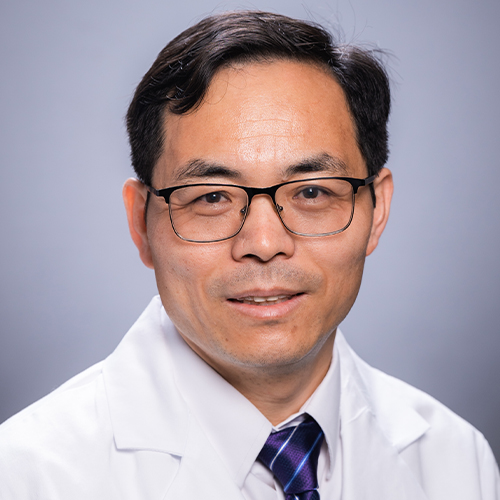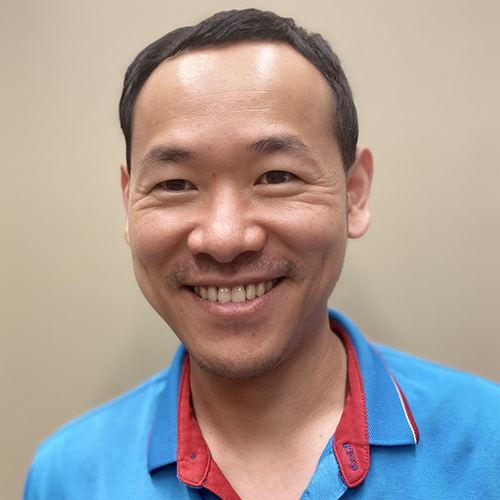Lewis Zhichang Shi, M.D., Ph.D., professor in the Department of Radiation Oncology, has been named the latest recipient of the school’s Featured Discovery award. This recognition celebrates notable research contributions made by faculty and highlights the impact of their scientific advancements.
Shi’s study “HIF1α-regulated glycolysis promotes activation-induced cell death and IFN-γ induction in hypoxic T cells” was published in Nature Communications. It reveals how low-oxygen or hypoxic microenvironments, like those found in tumors, modulate the function of T cells, which are key players in the immune system.
Shi and his team found that the protein HIF1α helps T cells adapt to hypoxia by promoting anaerobic glycolysis, a process that allows cells to make energy without oxygen. Without HIF1α, T cells produce less of the immune-boosting molecule IFN-γ and are less effective at regulating themselves through activation-induced cell death (AICD).
“T cells are the circulating soldiers in our body, combating pathological insults, including tumors,” said Shi. “One cardinal feature of the tumor microenvironment (TME) is hypoxia, which drastically impacts T cells’ survival and effector functions.”
They also discovered that supplementing these cells with acetate, an alternative energy source, restored their energy production and improved the effectiveness of immunotherapy in mice, highlighting the importance of cellular metabolism in enhancing immune responses against cancer.
“Conducting this research has been one of the most rewarding experiences of my career,” said first author Hongxing Shen. “We consistently observed reduced IFN-γ production under hypoxia—but not normoxia—in HIF1α-deficient T cells, in direct correlation with HIF1α-mediated AICD. I’m incredibly proud of this paper and deeply grateful for the invaluable support from our amazing collaborators.”
What compelled you to pursue this research?
Except for the few T cells residing in the upper airways, most T cells live in hypoxia. Despite the well-established role of HIF1α in orchestrating hypoxia-induced responses, whether and how HIF1α regulates effector functions of hypoxic T cells, such as IFN-γ production, has not been established.
What was your most unexpected finding?
We found that not only did HIF1α dictate production of IFN-γ (and other late cytokines), but it also acted as a key regulator of activation-induced metabolic reprogramming (AIMR) in hypoxic T cells. This was a surprising finding, given that we previously showed that Myc but not HIF1α controls AIMR in normoxic T cells (Wang, et al., 2011 Immunity ). This is a significant addition to our previous discovery of an essential role of HIF1α in the differentiation of IL-17-producing T cells and FoxP3-expressing regulatory T cells, under normoxia (Shi, et al., 2011 JEM ).
How do you feel your research will impact the science community?
This will change how we view the function of hypoxia-induced stabilization of HIF1α in tumor-infiltrating T cells (TILs). A commonly accepted dogma is that hypoxia in TME is a bad thing, which promotes tumorigenesis and/or tumor progression, inducing genomic instability, angiogenesis, metastasis, formation of cancer stem cells, and enforcing metabolic reprogramming (i.e., the widely known Warburg Effect). Our study indicates that if we can strategically utilize this feature to strengthen the HIF1α-glycolysis pathway in TILs, more efficacious therapeutic approaches can be developed. Significantly, immune checkpoint blockade therapies (ICBs, such as anti-CTLA-4 and anti-PD-1) rely on this axis to exert their therapeutic effects.
What is your research’s relevance to human disease?
As aforementioned, by sustaining the effector functions of TILs, HIF1α in T cells governs the therapeutic efficacy of ICBs. Given that therapeutic resistance is a pressing unmet medical need, genetically and pharmacologically boosting the function of HIF1α may manifest effective approaches to overcome ICB resistance, broadening the patient population that can benefit from immunotherapies.
When did you know you had an important discovery?
Well, this is a very long story. It is hard for me to narrow down a specific time, but the original idea was formed in 2013 when I was debating between establishing my lab at another institution or joining the group of SharmAllison (Dr. Jim Allison and Dr. Padmanee Sharma) at MD Anderson Cancer Center as a faculty member. Obviously, I took the path with the least resistance/less stress. In retrospect, that was probably the best career decision I’ve ever made, as it gave me an excellent opportunity to work with true pioneers in the immunotherapy field and more time to develop my research ideas on HIF1α. Time flies! I am happy that we have discovered something meaningful.
How has being at UAB and living in Birmingham affected your research?
I call UAB and Birmingham my second home. I have tremendously benefited from the strong support of my home department (Radiation Oncology) and O’Neal Comprehensive Cancer Center (O’Neal Invests Pre-R01 grant), collaborations with my collegial colleagues (Drs. James Bonner, Allan Zajac, Robert Welner, to name a few), and the fact that UAB is an internationally renowned biomedical research institution. Being surrounded by great people and indulged in cozy weather as well as beautiful views automatically boost our overall spirit and morale. Looking forward, with an emphasized focus on nurturing innovative and cutting-edge science at UAB and the new leadership in my department (Dr. Corey Speers), we will strive to make meaningful discoveries that will benefit our patients.
Featured Discovery
•
July 09, 2025